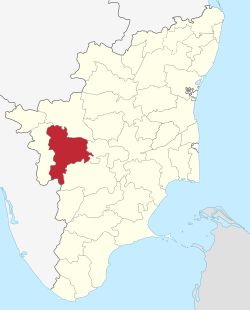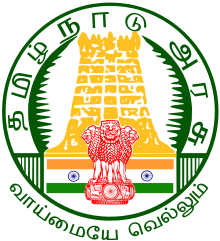Tiruppur district
Tiruppur District is one of the 38 districts of the Indian state of Tamil Nadu, formed in 22 February 2009. Dharapuram was the Largest Taluk By Area In Tiruppur District. The district is well-developed and industrialized. The Tiruppur banian industry, the cotton market,kangeyam bull and the famous uthukkuli butter, among other things, provide for a vibrant economy.[1] The city of Tiruppur is the administrative headquarters for the district. As of 2011, the district had a population of 2,479,052 with a sex-ratio of 989 females for every 1,000 males.
Tiruppur District | |
|---|---|
.jpg) Amaravathi reservoir | |
 Location in Tamil Nadu, India | |
| Coordinates: 11.18°N 77.25°E | |
| Country | |
| State | |
| Headquarters | Tiruppur |
| Population (2011) | |
| • Total | 2,479,052 |
| Languages | |
| • Official | Tamil |
| Time zone | UTC+5:30 (IST) |
| Vehicle registration | TN-39,TN-42,TN-78 |
| Website | http://tiruppur.tn.nic.in/ |
History
The district is named after the city of Tiruppur. In Mahabaratham Arjuna (Pandavas) returned the cattle captured by enemies and returned to Dharapuram (Nirai Meetal நிறை மீட்டல்). It eventually become Nirai Thiruputhal and become Tiruppur.
Since the 1990s, the formation of the new Tiruppur district had been urged by the exporters of Tiruppur.[2] Tiruppur city and surrounding region, where there is considerable industrial and business activities, was to be the core area. They believed that a new district would facilitate administration of the region and allow more aggressive development measures.[2] Tiruppur district was formed in 2009, carved out of the Coimbatore and Erode districts making it the 32nd district of Tamil Nadu[3] and one of the ten most industrialised and economically developed districts of Tamil Nadu.[2]
Before the formation of Tiruppur district, Avinashi, Madathukulam, Palladam, Tiruppur, and Udumalpet were taluks of Coimbatore district; and Dharapuram and Kangeyam were taluks of Erode district.[4] The new taluks of Madathukulam and Uthukuli were formed after the district was created.[5]
Geography and climate
Tiruppur district lies on the western part of Tamil Nadu bordering the Western Ghats and hence the district enjoys a moderate climate. The district is surrounded by Coimbatore district in the west, Erode district to the North and northeast and Karur district in the east and Dindigul district in the south east. To the south the district is surrounded by Kerala state (Idukki district). The district has an area of 516.12 sq.km.. The southern and south western parts of the district enjoys maximum rainfall, due to the surrounding of western ghats. The rest of the district lies in the rain shadow region of the Western Ghats and experiences salubrious climate most parts of the year, except the extreme east part of the district. The mean maximum and minimum temperatures for Tiruppur city during summer and winter vary between 35°C to 18°C. The average annual rainfall in the plains is around 700mm with the North East and the South West monsoons contributing to 47% and 28% respectively to the total rainfall. The major rivers flowing through the district are Noyyal and Amaravathi. The Amaravati river is the main source of irrigation in the district. Amaravathi Dam, which created Amaravathi Reservoir, is located at Amaravathinagar. Thirumurthy dam which is created by the PAP project is situated in this district. Both Amaravathi dam and Thirumurthy dam are the prime source of irrigation in the district, whereas Uppaar dam is another dam which receives water from seasonal rains.
Demographics
| Year | Pop. | ±% p.a. |
|---|---|---|
| 1901 | 516,618 | — |
| 1911 | 553,598 | +0.69% |
| 1921 | 588,291 | +0.61% |
| 1931 | 655,837 | +1.09% |
| 1941 | 754,273 | +1.41% |
| 1951 | 884,545 | +1.61% |
| 1961 | 949,859 | +0.71% |
| 1971 | 1,130,940 | +1.76% |
| 1981 | 1,324,480 | +1.59% |
| 1991 | 1,531,983 | +1.47% |
| 2001 | 1,920,154 | +2.28% |
| 2011 | 2,479,052 | +2.59% |
| source:[6] | ||
According to 2011 census, Tiruppur district had a population of 2,479,052 with a sex-ratio of 989 females for every 1,000 males, much above the national average of 929.[7] A total of 241,351 were under the age of six, constituting 123,612 males and 117,739 females. Scheduled Castes and Scheduled Tribes accounted for 15.97% and 0.22% of the population respectively. The average literacy of the district was 71.02%, compared to the national average of 72.99%.[7] The district had a total of 712,210 households. There were a total of 1,266,137 workers, comprising 130,331 cultivators, 216,945 main agricultural labourers, 36,139 in house hold industries, 785,181 other workers, 97,541 marginal workers, 5,486 marginal cultivators, 29,388 marginal agricultural labourers, 4,849 marginal workers in household industries and 57,818 other marginal workers.[8]
Administration and politics
Tiruppur district is administered by a collector, presently Dr. K. Vijaya Karthikeyan, I.A.S.
Parliamentary constituencies:
- Tiruppur(Part)
- Pollachi(Part)
- Coimbatore(Part)
- Erode(Part)
- The Nilgiris(Part)
Assembly constituencies:
- Tiruppur North
- Tiruppur South
- Palladam
- Dharapuram
- Kangeyam
- Avanashi
- Udumalpet
- Madathukulam
Revenue divisions
Municipal corporations:
Municipalities
Town Panchayats
- Muthur
- Mannarai
- Rudravathi
- Kannivadi
- Mulanur
- Kolathupalayam
- Chinnakkampalayam
- Avinashi (also spelled as Avanashi)
- Dhali
- Madathukulam
- Kaniyur
- Komaralingam
- Samalapuram
- Sankaramanallur
- Thirumuruganpoondi
- Kunnathur
- Uthukuli
- Kamanaickenpalayam
Economy
The city of Tirupur, at the heart of the district, is a textile center.[9] The agricultural sector is predominantly small and has marginal farmers with land holdings of less than two hectares.[10]
References
- "New Tiruppur district formed". The Hindu. 26 October 2008. Retrieved 27 October 2008.
- Gurumurhty, G. (21 June 2002). "TEA plea for Tiruppur distuxufdhduxhxif". The Hindu: Business Line. Archived from the original on 2 October 2012.
- Kumar, R. Vimal (18 June 2011). "In honour of Tiruppur Kumaran". The Hindu. Archived from the original on 26 April 2013.
- "2001 Taluk Details of Tamil Nadu State". Directorate of Census Operations, Ministry of Home Affairs, Government of India. Archived from the original on 9 April 2009.
- Tiruppur: Madathukulam & Uthukuli "Annexure-2 List of Newly formed Taluks after 2001 Census". Office of The Registrar General & Census Commissioner, Ministry of Home Affairs, Government of India. Archived from the original on 16 May 2011.
- Decadal Variation In Population Since 1901
- "Census Info 2011 Final population totals". Office of The Registrar General and Census Commissioner, Ministry of Home Affairs, Government of India. 2013. Retrieved 26 January 2014.
- "Census Info 2011 Final population totals - Tiruppur district". Office of The Registrar General and Census Commissioner, Ministry of Home Affairs, Government of India. 2013. Retrieved 26 January 2014.
- Narasimhan, T. E. (6 December 2012). "Tiruppur textile industry hopes to bounce back". Business Standard. Archived from the original on 26 April 2013.
- Kumar, R. Vimal (11 May 2012). "Integrated farming system to be introduced in Tirupur". The Hindu. Archived from the original on 26 April 2013.
